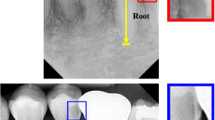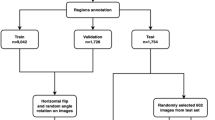Abstract
Radiography image processing is a technique used for processing radiography images using mathematical operations in which the input is a dental X- ray image or a sequence of X- ray images. The accuracy related segmentation for tooth images forms key point in computer based algorithms. To the great extent image processing techniques has two dimensional images used for processing. The methods of dental X-ray image diagnostic procedure are well established in the dentistry field. This is very useful to the dentist to get extra diagnostic information. Typically, in dental X-ray images, detection of caries and other hard tissues are challenging tasks. These x-ray images have unwanted noises that lead to poor diagnostic information. The main aim of proposed dental image processing system is to remove the unwanted noises at first with the help of robust Hybrid Binary Thresholding with Notch Filter (HBT-NF). The next step with the segmentation of caries, hard tissues from tooth lies with proposed Curvilinear Semantic Deep Convolutional neural network. Finally the teeth are separated from hard tissues and caries at high accuracy of 93.7%. Experimental results on the real dental X-ray images of the proposed system will give better effectiveness compared with other detection methods.









Similar content being viewed by others
Data availability
Mendeley Dataset available at DOI: https://doi.org/10.5281/zenodo.4457648
Due to privacy and ethical concerns, neither the data collected from Xpertz Dentofacial Center, India or the source of the data can be made available.
References
Abualhaj B, Weng G, Ong M, Attarwala AA, Molina F, Büsing K, Glatting G (2017) Comparison of five cluster validity indices performance in brain FET-PET image segmentation using k-means. Med Phys 44(1):209–220
Ali M, Khan M, Tung NT (2018) Segmentation of dental X-ray images in medical imaging using neutrosophic orthogonal matrices. Expert Syst Appl 91:434–441
Alok N, Krishan K, Chauhan P (2021) Deep learning-based image classifier for malaria cell detection. In: Machine Learning for Healthcare Applications, pp 187–197. https://doi.org/10.1002/9781119792611.ch12
Arshad A, Riaz S, Jiao L, Murthy A (2017) A semi-supervised deep fuzzy C-mean clustering for two classes classification. In: 2017 IEEE 3rd Information Technology and Mechatronics Engineering Conference (ITOEC). IEEE. pp. 365–370
Buhari MPA, Mohideen SK (2020) A combination of fuzzy positioned dental X-ray analysis model to presume the peculiar images. Int J Comput Appl 42(1):17–22
Dhiman G, Kaur A (2019) STOA: a bio-inspired based optimization algorithm for industrial engineering problems. Eng Appl Artif Intell 82:148–174
Divya KV, Jatti A, Joshi PR, Krishna SD (2019) A Correlative Study of Contrary Image Segmentation Methods Appending Dental Panoramic X-ray Images to Detect Jawbone Disorders. In: Progress in Advanced Computing and Intelligent Engineering. Springer, Singapore, pp 25–35
Gong S, Li G, Zhang Y, Li C, Yu L (2019) Application of static gesture segmentation based on an improved canny operator. The Journal of Eng 2019(15):543–546
Guido RC (2016) A tutorial on signal energy and its applications. Neurocomputing 179:264–282. https://doi.org/10.1016/j.neucom.2015.12.012
Guido RC (2019) Enhancing Teager energy operator based on a novel and appealing Concept: Signal Mass. Journal Franklin Inst 356:2346–2352. https://doi.org/10.1016/j.jfranklin.2018.12
Gupta VK, Shukla SK, Rawat RS (2022) Crime tracking system and People’s safety in India using machine learning approaches. Int J Modern Res 2(1):1–7
Huang H, Meng F, Zhou S, Jiang F, Manogaran G (2019) Brain Image Segmentation Based On Fcm Clustering Algorithm And Rough Set. Ieee Access, Special Section On New Trends In Brain Signal Processing And. Analysis 7:12386–12396
Jain KR, Chauhan NC (2019) Clustering Techniques for Dental Image Analysis. In: Dental Image Analysis for Disease Diagnosis. Springer, Cham, pp 103–128
Karthick G, Harikumar R (2017) Comparative Performance Analysis of Naive bayes and SVM classifier for Oral X-ray images. In: 2017 4th International Conference on Electronics and Communication Systems (ICECS). IEEE. pp. 88–92
Kaur S, Awasthi LK, Sangal AL, Dhiman G (2020) Tunicate swarm algorithm: a new bio-inspired based metaheuristic paradigm for global optimization. Eng Appl Artif Intell 90:103541
Khammari M (2019) Robust face anti-spoofing using CNN with LBP and WLD. IET Image Process 13:1880–1884
Krishan A, Mittal D (2019) Effective segmentation and classification of tumor on liver MRI and CT images using multi-kernel K-means clustering. Biomed Eng/Biomedizinische Technik 65:301–313
Kumar R, Dhiman G (2021) A comparative study of fuzzy optimization through fuzzy number. Int J Modern Res 1(1):1–14
Kumar A, Bhadauria HS, Singh A (2020) Semi-supervised OTSU based hyperbolic tangent Gaussian kernel fuzzy C-mean clustering for dental radiographs segmentation. Multimed Tools Appl 79(3):2745–2768
Kumari S, Singh M, Kumar K (2021) Prediction of Liver Disease Using Grouping of Machine Learning Classifiers. In: Tripathi M, Upadhyaya S (eds) Conference Proceedings of ICDLAIR2019. ICDLAIR 2019. Lecture notes in networks and systems, vol vol 175. Springer, Cham. https://doi.org/10.1007/978-3-030-67187-7_35
Lei T, Jia X, Zhang Y, Liu S,Meng H, Nandi AK (2019) Superpixel-based fast fuzzy C-means clustering for color image segmentation. IEEE Trans Fuzzy Syst 27(9):1753–1766
Li Q, Zheng M, Li F, Wang J, Geng Y-A, Jiang H (2017) Retinal Image Segmentation Using Double-Scale Non-Linear Thresholding On Vessel Support Regions. CAAI Trans Intell Technol 2(3):109–115
Lin W, Hasenstab K, Moura Cunha G, Schwartzman A (2020) Comparison of handcrafted features and convolutional neural networks for liver MR image adequacy assessment. Sci Rep 10:20336. https://doi.org/10.1038/s41598-020-77264-y
Lingappa AZA, Astuti ER, Kurita T (2018) Segmenting Tooth Components in Dental X-Ray Images Using Gaussian Kernel-Based Conditional Spatial Fuzzy C-Means Clustering Algorithm. International Society for Optics and Photonics
Su L et al (2018) Delineation of carpal bones from hand X-ray images through prior model, and integration of region-based and boundary-based segmentations. IEEE Access 6:19993–20008. https://doi.org/10.1109/ACCESS.2018.2815031
Negi A, Kumar K, Chauhan P (2021) Deep neural network-based multi-class image classification for plant diseases. In: Agricultural informatics, pp 117–129. https://doi.org/10.1002/9781119769231.ch6
Said E, Fahmy GF, Nassar D, Ammar H (2018) Dental x-ray image segmentation. In: Biometric Technology for Human Identification, vol 5404. International Society for Optics and Photonics, pp 409–417
Shang R, Yuan Y, Jiao L, Hou B, Member, Esfahani AMG, Stolkin R (2017) Fast Algorithm For Sar Image Segmentation Based On Key Pixels, 2017, IEEE J Appl Earth Observ Remote Sens 10(12):5657-5673.
Shen L, Liu M, Wang C, Chen W, Sun Z, He W, Wang Y (2020) Efficient critical point detection for curvilinear structures using a ring-like ray-shooting model. IEEE Trans Instrum Meas 70:1–11
Song J, Zhang Z (2019) A Modified Robust FCM Model with Spatial Constraints for Brain MR Image Segmentation. Information, MDPI 24(10):1–15
Strisciuglio N, Azzopardi G, Petkov N (2019) Robust inhibition-augmented operator for delineation of curvilinear structures. IEEE Trans Image Process 28(12):5852–5866
Suresh R, Nagaraja Rao A, Eswara Reddy B (2019) Detection and classification of normal and abnormal patterns in mammograms using deep neural network, Concurrency Computation Pract Exper. , John Wiley & Sons, Ltd. ,Special Issue
Vaishnav PK, Sharma S, Sharma P (2021) Analytical review analysis for screening COVID-19. Int J Modern Res 1:22–29 Spotted hyena optimizer: a novel bio-inspired based metaheuristic technique for engineering applications
Wang H, Du M, Zhou J, Tao L (2019) Weber Local Descriptors with Variable Curvature Gabors Filter for Finger Vein Recognition. IEEE Access 7(9):108261–108277
Yin S, Tien M, Yang H (2020) Prior-apprised unsupervised learning of sub-pixel curvilinear features in low signal-to-noise images. Biophys J 118:2458–2469
Zheng J, Zhang D, Huang K (2018) Yuanxi Sun, Adaptive image segmentation method based on the fuzzy c-means with spatial information. IET Image Process 12(5):785–792
Funding
All authors have participated in (a) conception and design, or analysis and interpretation of the data; (b) drafting the article or revising it critically for important intellectual content; and (c) approval of the final version. This manuscript has not been submitted to, nor is under review at, another journal or other publishing venue.
Author information
Authors and Affiliations
Corresponding author
Ethics declarations
Conflict of interest / competing interest
The authors have no affiliation with any organization with a direct or indirect financial interest in the subject matter discussed in the manuscript.
Additional information
Publisher’s note
Springer Nature remains neutral with regard to jurisdictional claims in published maps and institutional affiliations.
Rights and permissions
Springer Nature or its licensor holds exclusive rights to this article under a publishing agreement with the author(s) or other rightsholder(s); author self-archiving of the accepted manuscript version of this article is solely governed by the terms of such publishing agreement and applicable law.
About this article
Cite this article
Rajee, M.V., Mythili, C. Novel technique for caries detection using curvilinear semantic deep convolutional neural network. Multimed Tools Appl 82, 10745–10762 (2023). https://doi.org/10.1007/s11042-022-13789-w
Received:
Revised:
Accepted:
Published:
Issue Date:
DOI: https://doi.org/10.1007/s11042-022-13789-w




